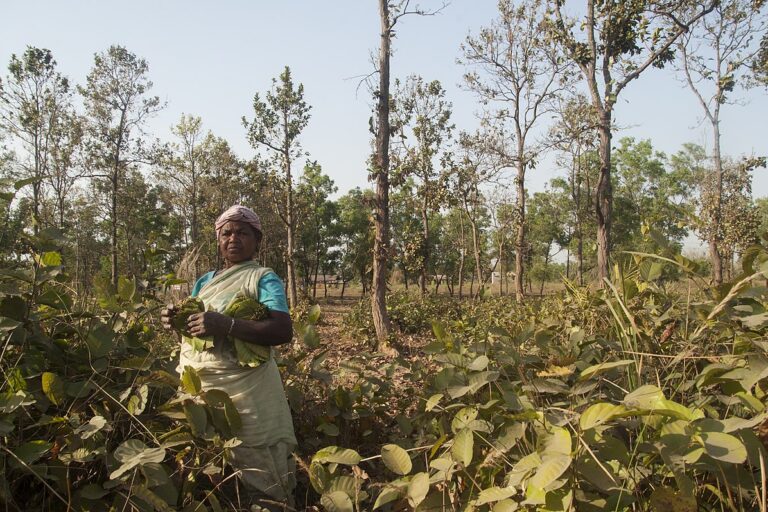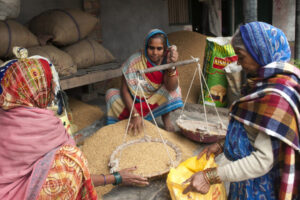A Look At Gender In Initiatives Around Forest Landscape Restoration
Mar 8, 2024 | Pratirodh Bureau
A woman collecting leaves for making plates in West Bengal. A successful restoration initiative critically rests on the participation of those whose lives depend on the services and resources available from a given landscape – particularly the local, indigenous groups of people, especially women and other marginalised groups, write the authors of this commentary (Photo by Sagnik Samanta/Wikimedia Commons)
- A successful restoration initiative critically rests on the participation of those whose lives depend on the services and resources available from a given landscape, particularly the local, indigenous groups of people, especially women and other marginalised groups.
- Women have differing perspectives on approaches for restoration, unique traditional knowledge and expertise and distinct aspirations in terms of benefits from forest landscape restoration. Initiatives must be designed to harness these varied capabilities, while also viewing this diversity as a prospect for empowerment.
- Empowerment rests not just on the presence of a well-structured legal framework but also on the administrative accessibility of these frameworks to women and more importantly on their widespread acceptance within the community they live in
A landscape approach to forest restoration necessitates an integrated perspective that requires understanding the interdependent relationship between people and nature and ways that human activities both depend on and impact ecosystem services. Forest-related ecosystem services include water provision, pollination, biodiversity conservation, soil formation and provisioning services such as wood and non-timber forest products. These services might be affected due to forest degradation, propelled by human activities and exacerbated by climate change related phenomena, such as more intense and prolonged floods and droughts.
The landscape approach seeks to understand various land use forms, their relationship with ecosystem services and embark on restoration activities which ultimately lead to improving the resilience of local communities. Such an integrated perspective must consider complex socio-ecological systems within the specific landscape. A successful restoration initiative critically rests on the participation of those whose lives depend on the services and resources available from a given landscape – particularly the local, indigenous groups of people, especially women and other marginalised groups. A detailed understanding of not only their economic aspirations but also the specific social norms, the cultural context, and the existing governance mechanisms and power structures within the community aids in achieving the social and ecological goals of restoration.
A key aspect of engendering such social inclusion is integrating gender into landscape restoration design and implementation. It is imperative that we understand gender as a social construct, wherein gender roles and relations refer to the “socially” defined responsibilities, behaviours and interactions that are “considered” appropriate. The authors do understand the need to look beyond the gender binary and that identities beyond men and women have always existed. However, only for the sake of this article, we talk in terms of men and women.
It is pertinent to point out that gender roles and gender relations are context- specific and can change over time, being shaped by societal and historical developments. Many times, this leads to stereotypes, such as that men are thought to be more suited for physically demanding work such as logging, while community or household-based activities like gathering non-timber forest products (NTFPs) and fuelwood collection are more appropriate for women. Such divisions fail to adequately represent the required skills and physical aptness for any given tasks, as collecting NTFPs or fuelwood can be physically extenuating. They do not portray the range of daily tasks that men and women are traditionally assigned and how these might add to the overall work burden disproportionately.
Due to the already existing gender stereotypes and gender-based discrimination, it is still extremely difficult for women in India to enter the formal labour market and access decent work. Challenges related to access to employment, choice of work, working conditions which are sometimes not conducive for women workers, safety concerns, employment security, wage parity, discrimination, and double and triple burden of work through unpaid household and care work. Women are predominantly occupied in the informal sector, where they are highly exposed to the risk of exploitation and lack formal protection.
As already mentioned, FLR is not just about understanding the forest in isolation, it also includes critical aspects like food and water security, nutrition, and agriculture enhancement (via availability of pollinators). People are both invaluable to the sustained provision of ecosystem services, however the role and contribution of women are often ignored and not acknowledged appropriately. Women have differing perspectives on approaches for restoration, unique traditional knowledge and expertise and distinct aspirations in terms of benefits from FLR. Initiatives must be designed to harness these varied capabilities, while also viewing this diversity as a prospect for empowerment.
Understanding Empowerment
Empowerment should be understood or evaluated in terms of access to tangible resources, such as control over physical, financial, or human resources, and also intangible resources like positive change in attitudes (of family members and the community), societal norms and beliefs and gendered relations. From a normative perspective and long-term sustainable impact, initiatives should at the very outset involve women in decision making; and parallelly try to understand any structural barriers that limit their participation in community life and decision-making. This in no way means limiting participation of men, but rather designing initiatives that capture existing relationships between men and women at household and community levels and also promote a levelling of gender-based power relations.
The Reach-Benefit-Empower-Transform (RBET) framework developed by the International Food Policy Research Institute (IFPRI) and the CGIAR Research Program on Fish Agri-Food Systems helps distinguish between approaches that reach women, such as by including them in program activities; those that benefit women by improving their circumstances in some way; those that empower women, by strengthening their ability to make and put into action strategic life choices; and those that transform gender relations within and outside the household, such as by changing attitudes and governance structures at the community level.
Gender-Responsive Approach
A gender-responsive approach to FLR recognises and addresses the different needs, experiences and vulnerabilities faced by women and other marginalised communities right from conceptualisation of any restoration initiative, over design and on-the-ground implementation, monitoring, to policy mainstreaming and capacity building. It goes beyond merely increasing participation of or outreach to women by designing landscape specific restoration measures that guarantee real and tangible benefits to women. These benefits could be in respect of increasing rights, resources, and representation of women, as reflected in Towards feminist rural development cooperation by GIZ & CFFP and German Federal Ministry of Economic Cooperation & Development Feminist Development Policy. Rights can include equality in terms of owning and inheriting land, education which has a positive spillover on health of entire family, freedom of movement which has significantly increases economic mobility etc. among other fundamental rights. Resources refers to access to agricultural finance, technology, and equipment etc. Representation concerns decision making through formation of cooperatives, self-help groups, and other participatory institutional networks at the local level. These benefits could also be viewed in terms of enhancing skill sets in terms of livelihood trainings, increase in income or productivity by developing and supporting local value chains.
To take the example of the 2006 enacted Forest Rights Act. It recognises and vests forest rights to forest-dwelling communities and places women’s right to land as equal to that of men, grants land ownership ‘rights’ to women and also encourages their ‘representation’ in the forest rights committees formed under the Act. The Act is very well placed for women to contribute to making forest management decisions, involving them in governance and engaging them in designing livelihood activities based on their traditional knowledge and cultural practices. However, empowerment rests not just on the presence of a well-structured legal framework but also on the administrative accessibility of these frameworks to women and more importantly on their widespread acceptance within the community they live in.
Gender-Transformative Approach
A gender-transformative approach to FLR recognises the need to empower women, expanding the conversation beyond benefits. It includes empowerment in terms of one’s agency to shape their lives in a self-determined way and brings into focus the structural and systemic causes of discrimination. This includes critically examining and then fixing the root cause of prevailing discriminatory laws, unequal social norms and practices, discriminatory attitudes, gender roles and stereotypes existing in communities within a landscape. For example, research by Centre for Social Justice highlighted that even if rural women are aware of their rights (say, right to inherit property), societal pressures like the fear that staking their claim might cause disharmony within the family, prevents women from claiming them.
Gender-transformative approaches are distinct from gender-responsive approaches in that the latter systematically integrates the specific needs of gender into their measures (For example, number of women and men benefiting from FLR-related measures: credit schemes; cash transfers; procurement opportunities; tools and resources; training workshops, as outlined in FAO’s Monitoring Gender Equality and Social Inclusion in forest and landscape restoration programmes), while the former aims to actively transform existing gender-specific inequalities (For example, women’s and men’s changed attitudes toward disempowering gender norms with relevance to FLR, as noted in the Feminist Development Policy and German Federal Ministry of Economic Cooperation).
Achieving sustainable change in norms and behaviours requires the involvement of the entire society and can only happen over a longer period of time. Involving the traditional decision makers, i.e., the men and elderly of the household and community as active agents of change along with women may enhance the acceptance of different approaches. What needs to be kept in mind is the inherent interdependence of social and ecological systems. Whether it is designing a responsive approach or a transformative approach, working towards consciously crafting gender into FLR initiatives – by acknowledging that men and women should have an equal agency in all levels of planning, design, and benefits – is a necessary first step in this direction.

The Indo German bilateral cooperation project Restore, Conserve and Protect Forest and Tree Cover for NDC Implementation in India (RECAP4NDC) aims to work with local communities in forest and fringe forest areas and help them actively participate in the decision-making process through participatory institutional networks including Joint Forest Management Committees (JFMCs), Biodiversity Management Committees (BMCs), etc. and improve their livelihoods with better access to markets. The approach will derive insights from the Feminist Development Policy of the German Federal Ministry of Economic Cooperation. Target groups also include the vulnerable and poor sections of the population and disadvantaged groups in the rural areas where livelihoods depend heavily on the use of forest ecosystem services and who are currently or potentially most affected by the degradation of natural resources and climate change. The project will follow a ‘Do No Harm‘ approach and a persistent ‘Do Good‘ approach in all elements and initiatives. RECAP4NDC would aim to ensure an equal involvement of women in policy and decision-making processes, where applicable, encouraging their representation in administration of villages. Further, the project will continuously assess and monitor potential risks but also contributions to gender equality especially with support by its implementation partner the International Union of Conservation of Nature (IUCN), which has a focus on women rights with regard to land management.
(Produced under Creative Commons from Mongabay-India. Read the original article here)
